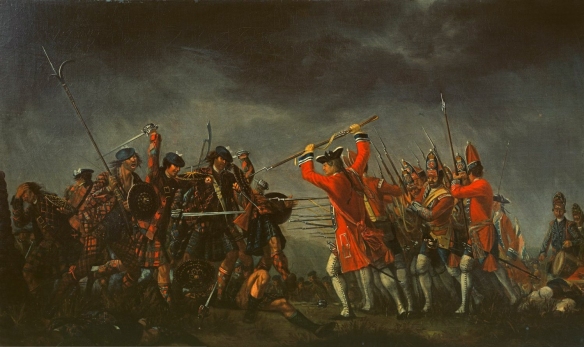An incident in the rebellion of 1745, by David Morier
PRINCIPAL COMBATANTS: Jacobites (supporters of the Young Pretender, Charles Edward Stuart, “Bonnie Prince Charlie”) vs. English government forces
PRINCIPAL THEATER(S): Scottish Highlands and northern England
DECLARATION: None
MAJOR ISSUES AND OBJECTIVES: The Jacobites wanted to bring Charles Edward Stuart to the English throne.
OUTCOME: After scoring many victories against the English, the Jacobites were definitively crushed at the Battle of Culloden Moor, and the last Jacobite rebellion ended.
APPROXIMATE MAXIMUM NUMBER OF MEN UNDER ARMS: English, 10,000; Jacobite, 8,000
CASUALTIES: At Culloden: English, 300 killed; Jacobite losses approached 8,000 at this battle
TREATIES: None
This renewal of Jacobite support for the restoration to the British throne of descendants of James II (1633–1701) and JACOBITE REBELLION (1715–1716]) was popularly called “The Forty- Five.” In 1745, Charles Edward Stuart (1720–88), son of the “Old Pretender,” James Edward Stuart (1688–1766), and grandson of King James II, came to Scotland with just seven followers, but, when his father was again proclaimed by the Jacobites King James III, “Bonnie Prince Charlie” or the “Young Pretender” (as Charles Edward was dubbed) drew to him a large following from among the Scottish clans, about 2,000 men. He led them skillfully, this last feudal army to be raised in Europe, capturing Perth, then defeating two regiments of the Hanoverian king’s troops at Coltbridge. General Sir John Cope (d. 1760) marched north from Stirling with a 4,000-troopstrong British army to intercept the Scottish forces. When he found them entrenched and apparently impregnable along the Corrieyairack Pass, he turned for Inverness, giving Charles leave to proceed on to Edinburgh, where he took the town but not the castle. Meanwhile, Cope sailed from Inverness to the Firth of Forth, landing his army to engage the Jacobites at Prestonpans on September 21, 1745. Although outnumbered, the Highlanders charged into Cope’s command and routed the government forces. The royalists lost 1,000 as prisoners, and hundreds were killed or wounded.
After the victory at Prestonpans, Bonnie Prince Charlie invaded Lancashire, England, with an army now some 5,500 strong, including elements of Scots and Irish regiments under French command. To avoid a superior force at Newcastle, which included some 6,000 Dutch soldiers, Charles turned south, capturing Carlisle and Manchester. From there he raided Derby on December 4.
With British forces confused and ill-deployed, nothing— no army, at least—now stood between the Pretender to the throne and the throne itself in London. The 4,000 regulars deployed in the city were quickly mobilized to protect its northern approach at Finchley, but on December 6 Charles and his advisers—having recruited fewer to their cause than they’d hoped and cognizant that hostile and superior forces were perhaps a day’s march away— decided to retreat to Scotland, a decision whose soundness would be debated down through the ages.
In any case, Charles returned to Scotland, with English forces in pursuit. On January 17, 1746, at Falkirk, the Jacobite army, now numbering about 8,000 men, suddenly turned on its pursuers, whose numbers were approximately equal. The Jacobites charged, breaking the English line and inflicting heavy casualties: 600 killed, 700 captured. The English also lost their baggage and artillery. Losses to the Jacobites were about 150 killed and wounded.
From Falkirk, the Jacobites marched north to occupy Inverness. The English army was reorganized under King George II’s (1683–1760) son the duke of Cumberland (1721–65) (William Augustus), who skillfully deployed his 10,000 men, with artillery, at Culloden Moor on April 16, 1746. Thus positioned, he allowed the Highlanders to do what had served them so well in the past—charge— only, this time, the English defenses were so well prepared that each charge proved costly to the Jacobites, reducing their already outnumbered forces. Finally, Cumberland’s cavalry charged and swept all before them. The Scots ran, only to be cut down. Cumberland, determined to put an end to the rebellion, had ordered that no quarter be given, and thus even the wounded were slain. Most of the Jacobite force at Culloden was killed, whereas Cumberland— dubbed “the Butcher”—lost no more than 300 men. With this battle, “the Forty-Five” ended, but Bonnie Prince Charlie escaped. He hid in the Highlands until he eventually returned to France, where he died, a permanent exile.
Further reading: Jeremy Black, Culloden and the ’45 (Gloucester, England: Palgrave Macmillan, 1991); Leo Gooch, The Desperate Faction?: The Jacobites of North-East England, 1688–1745 (Hull, England: University of Hull Press, 1995); Bruce Lenman, The Jacobite Risings in Britain, 1689–1746 (London: Scottish Cultural Press, 1995); F. J. McLynn, The Jacobite Army in England, 1745: The Final Campaign (Atlantic Highlands, N.J.: Humanities Press, 1983); Stuart Reid, 1745: A Military History of the Last Jacobite Rising (Staplehurst, Kent: Spellmount, 1996).
